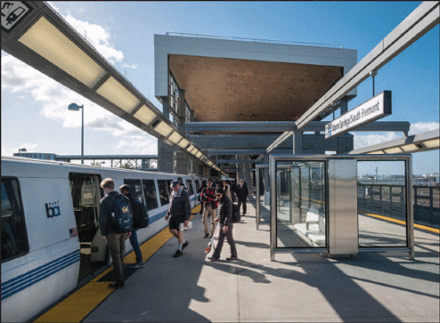|
San Francisco's Bay Area Rapid Transit
(BART) Warm Springs Extension opened for service on Saturday, 25 March 2017.
The 5.4-mi extension connects the existing Fremont Station to the new Warm
Springs/South Fremont Station.
The new station includes 2,082 parking
spots, including 42 electronic car charging stations as well as intermodal
connections to Alameda-Contra Costa (AC) Transit and private shuttles. Bike
lockers and bike racks were also installed to ensure that the station is fully
accessible to pedestrians and cyclists. It also includes a bus transit center
to provide easy connections between the trains and AC Transit buses.

“This will be history in the making,” said
BART Director Tom Blalock, who serves Fremont and has been a leader in making
the extension a reality. “This will bring BART service to the residents of
fast-growing South Fremont. They'll have a reliable, environmentally
responsible alternative to driving on the sometimes nightmarish Nimitz Freeway.”
The Warm Springs Extension also paves the
way for BART to Silicon Valley, a Santa Clara Valley Transportation Authority
project that's underway BART to Silicon Valley extends the line south to San
Jose and then north to Santa Clara. A firm date for opening the extension
beyond the Warm Springs Station has not yet been announced.
The Warm Springs Station, located at 45193
Warm Springs Boulevard, has nearly 2,000 solar panels installed on the station
roof and on parking lot canopies. They will operate for at least 20 years under a
“power purchase agreement” between BART and SolarCity, a supplier of solar
panel-generated electricity that operates in 27 states and in Washington, DC.
The panels went into operation on 29 September 2016 and have the capacity to
generate 512 kW of power, which is more than enough to serve all the daytime
electricity needs for the Warm Springs/South Fremont Station.
The Warm Springs project includes two rail
lines, three control rooms, five traction power facilities, and two box
tunnels, including a 1-mi cut-and-cover tunnel under Lake Elizabeth in Fremont
Central Park. Although the tunnel work was performed underneath the park for
approximately three and one-half years, the park and its facilities remained
open to the public the entire time.
An eight-acre wetland site was part of the
environmental mitigation to offset the impact of the project. A section of the
tunnel near Fremont Central Park that passes by Hayward Fault as well as an
adjoining aquifer posed a significant technical challenge.
To protect the
tunnel from potential earthquake activity, its innovative design includes
seismic joints and a flexible, self-repairing waterproofing gel that allows the
subway box to withstand a major earthquake while maintaining a relatively
water-free environment inside the tunnel.
Full article: IEEE Vehicular Technology
Magazine, Volume 12, Number 3, September 2017 |